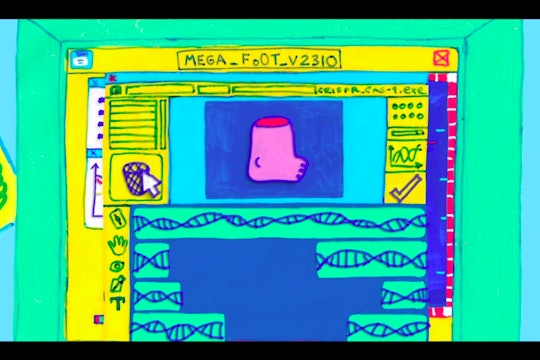

Produced in partnership with ASU Center for Science and the Imagination
My greatest genetic engineering fear: that we'll try to erase our flaws
Deciding what's a flaw is more complicated than it seems
I still remember the look of profound pity on the clerk’s face when I asked where the pregnancy tests were. I’m sure it all looked so obvious: the young woman standing with a young man in a dollar store in a college town. We walked in silence to the family planning section, but then I realized my mistake.
“Actually, do you have a crate of these in the back?” I said, “We’re going to need, like, a hundred.”
My teammates and I, including the young man buying pregnancy tests with me, were competing in the International Genetically Engineered Machine (iGEM) Competition, an annual synthetic biology contest. Our mission that summer was to invent a simpler, less expensive way of testing for whooping cough – using repurposed pregnancy tests.
So, did it work? Like many iGEM projects, not exactly. In the popular imagination, synthetic biology conjures up images of bio-hackers inventing new forms of life in their basements. But as anyone who has tried it can tell you, despite incredible advances in the field, engineering biology is still anything but simple.
For those who know the formidable challenge of engineering even the simplest aspect of biology, fears about the power of genetic engineering can seem overblown. That year at iGEM, a special agent in the FBI’s Weapons of Mass Destruction Directorate gave a talk. He mentioned a man who was able to order part of the genome of deadly virus online, so someone asked exactly how much of the genome he was able to order. When the special agent answered, the whole auditorium burst out laughing. It was like saying he’d ordered “part of a nuclear warhead” because he’d purchased a single screw.
Now, with the recent attempts to engineer human embryos using CRISPR, I’ve found myself sitting around dinner tables assuring people that there’s no reason to panic. I tell them that our basic understanding of genetics is nowhere near good enough to engineer enhanced intelligence or super strength. But, if I’m being completely honest, I’ll admit that I have a much simpler fear. Not that we’ll create monsters or super-humans, but that we’ll try to erase our flaws. That’s a problem because the question, “What is a genetic flaw?” is much more complicated than it seems.
Take sickle-cell, for example. Sickle-cell disease is caused when a person inherits two mutant copies of the gene for hemoglobin. It’s the sort of thing that many people would think is unproblematic to engineer away. But the interesting thing about sickle-cell is that if you inherit only one copy of the mutant gene, it confers resistance to malaria. And malaria has had such a devastating impact throughout human history that evolution actually selected for these mutations, even though they cause disease when inherited as a pair.
Sickle-cell disease is one of many genetic conditions that could be cured using genome editing. So scientists have been working for decades to figure out a way to go in and “fix” these mutant genes in affected individuals. But what’s new (and objectionable) about modifying embryos is that it affects germline cells. Germline cells are the cells in your body that can transmit genetic information to the next generation. In other words, sperm and eggs. If you make a change to the germline, that doesn’t just change the individual in question; it changes all of their descendants. That means we have to account for the safety and necessity of a genetic modification across generations, not just in one person.
In the case of sickle-cell, if we could go back and erase those mutations from all of humanity, fewer people would suffer from sickle-cell disease, but more would die of malaria. So would that be good, bad, or both?
The truth is, it’s often difficult to say whether a mutation is good or bad in itself. For instance, people who have a certain version of CCR5, a protein on the surface of white blood cells, are resistant to HIV infection but more susceptible to West Nile. Whether that mutation is good or bad depends on which pathogen that person is more likely to encounter. So a genetic change that’s clearly beneficial to one person could easily be detrimental to their great-great-grandchild living halfway across the world.
When we consider disability, the question only becomes murkier. In Do Deaf People Have a Disability?, psychology professor Harlan Lane of Northeastern University points out that the problem with deafness is not a physiological one, but one of marginalization and lack of accommodation from mainstream society. In the company of those who know sign language, deafness is no barrier to communication at all.
When genome editing comes of age, we will have the option to engineer things like deafness away. But in doing so, we would be destroying a rich culture and an entire language. We should be wary of the temptation to engineer people to better fit the world as it is, rather than doing the hard work of creating a world that is more accommodating of difference.
Lane also points out that what is considered illness is highly changeable. Homosexuality and gender non-conformity, until recently considered abnormal and pathological, are increasingly accepted as normal types of human variation. And it can go the other way, too. In recent decades, alcoholism has gone from being considered a moral failing to being a type of disease. So how can we be sure that today’s illness isn’t tomorrow’s normal variation, or vice versa?
In stark scientific terms, we know that a species with more genetic diversity is more likely to survive, because it can adapt more easily to an environment that’s constantly changing. But putting aside biology, we might still wish to create societies with more diversity and not less.
The technology of genome editing has enormous potential to relieve suffering, and it may be that in some cases, we will decide that it is justified to remove certain mutations altogether. But as we face those decisions, we must keep in mind how hazy the line can be between benefit and detriment, disease and natural variation. In the words of Brazilian writer Clarice Lispector, “even self-improvement can be dangerous. You never know which defect holds up the whole building.”
